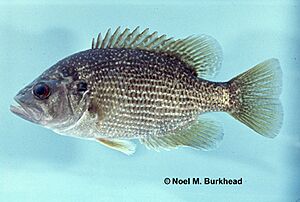Roanoke bass facts for kids
Quick facts for kids Roanoke bass |
|
|---|---|
 |
|
| Conservation status | |
| Scientific classification |
The Roanoke bass (Ambloplites cavifrons) is a special type of freshwater fish. It is part of the sunfish family, called Centrarchidae. This fish lives only in rivers in the eastern United States. You can find it in the states of Virginia and North Carolina.
Contents
What Does the Roanoke Bass Look Like?
The Roanoke bass has a strong, flat body. It has a big mouth at the end of its head. Its cheeks have very few scales. The fin on its underside, called the anal fin, has a dark edge. Its side fins, the pectoral fins, are round. The tail fin, or caudal fin, is slightly notched. This fish has large, red eyes. Its body is usually dark brown or olive green.
How is it Different from Other Fish?
The Roanoke bass looks a lot like the rock bass (Ambloplites rupestris). People often mix them up, even though their colors are different. The Roanoke bass is dark olive green or olive brown on its back. Its sides are grayish, and its belly is white. It has smaller spots on its scales than the rock bass. It also has pale, whitish, or yellowish spots on its upper body. The front of its head is a bit curved inward. This, along with fewer scales on its cheek, helps tell it apart from the rock bass.
Size of the Roanoke Bass
The biggest Roanoke bass ever recorded was about 36 centimetres (14 in) long. The heaviest one weighed about 620 grams (1.37 lb).
Where Do Roanoke Bass Live?
Roanoke bass naturally live in a few river systems. These rivers are in Virginia and North Carolina, along the Atlantic coast of the United States. You can find them in the Chowan, Roanoke, Tar, Neuse, and Cape Fear river systems. However, they seem to have disappeared from the very top parts of the Roanoke system. They are also no longer found in the middle New River and parts of the James River. But people have tried to bring them back to these areas.
What They Eat and Where They Live
Roanoke bass live in large creeks, streams, and small rivers. They like clear water, but they can handle some cloudy water too. They also live in darker waters that come from swamps, like in the Nottoway and Blackwater rivers. You often find them in deep, fast-moving parts of rivers. They also like areas around rocks and gravel, or at the start of deeper pools.
What Do They Eat?
These fish are predators. This means they hunt and eat other animals. They eat many different things, like insects, worms, leeches, and crayfish. They also eat smaller fish, such as fathead minnows, golden shiners, and gizzard shad.
Nesting Habits
When kept in special tanks, male Roanoke bass build and guard nests. They make these nests in shallow water. They prefer to build them on gravel. They usually avoid sandy or muddy places for their nests.
Protecting the Roanoke Bass
Experts from the IUCN (a group that studies nature) say the Roanoke bass is of "least concern" for now. This means it's not in immediate danger of disappearing globally. However, another group called NatureServe says the species is "vulnerable". This means it could be at risk in the future.
Why is it Vulnerable?
NatureServe explains that the Roanoke bass population has gone down. This is because their habitat (the places they live) is getting damaged. Also, they have to compete with rock bass that have been introduced to their areas. Sometimes, they even mix with rock bass, which can cause problems for the species.
In Virginia, the Roanoke bass is a "species of special concern." This means people are watching it closely to make sure it stays healthy. The North Carolina Natural Heritage Program also lists it as "significantly rare."
Roanoke Bass and People
People enjoy fishing for Roanoke bass. The IGFA (International Game Fish Association) keeps track of world records for fish. The world record for the heaviest Roanoke bass caught was 0.62 kg (1 lb 6 oz). This fish was caught in the Nottoway River in Virginia in 1991. More recently, on May 7, 2023, a Roanoke bass weighing 2-pound-3-ounce (0.99 kg) was caught in the Dan River in Virginia.



